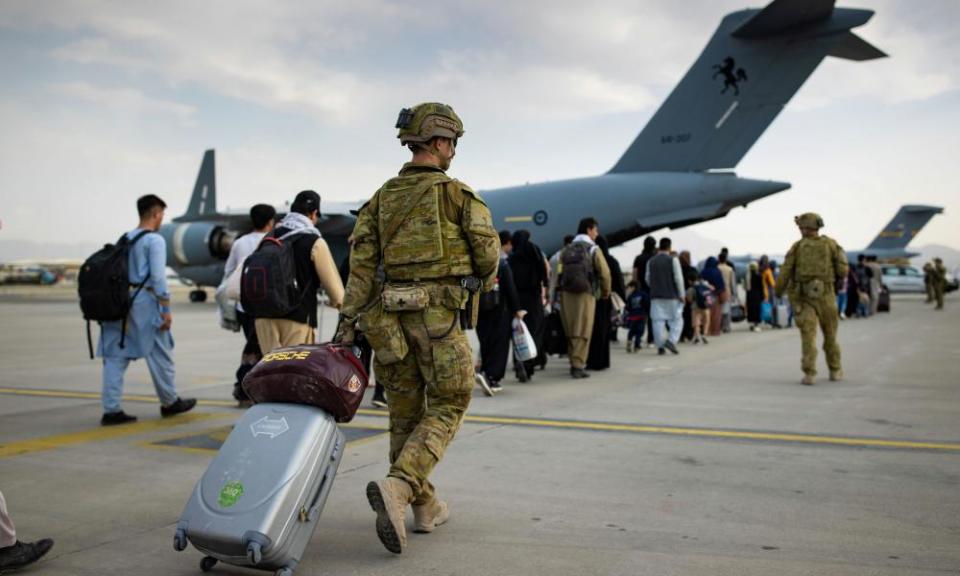More than 45,000 Australians stranded overseas registered for government help

The number of Australians stranded overseas who need government help to return home has surged to more than 45,000, after a further tightening of arrival caps and the deteriorating situation in Afghanistan.
While the register of stranded Australians was initially set up by the Department of Foreign Affairs and Trade for those requiring assistance because of Covid-related travel issues, registrations from Australians left behind in Taliban-controlled Afghanistan have increased significantly since the evacuation mission ended late last month.
Afghanistan is now among the top five countries with the greatest number of Australians seeking government help to return, along with India, the United Kingdom, the United States and Pakistan.
Related: Airlines warn NSW may reopen to international travel but with few planes to service huge demand
Outside Afghanistan, stranded Australians have been hit by the decision of some airlines including Singapore Airlines and All Nippon Airways to further cut their already reduced services into Australia in coming months, taking the number of citizens and permanent residents now registered with Dfat to 45,200.
That’s up from 38,000 who were registered on its assistance list at the end of July.
Of the total number of those registered as stranded, 4,700 are considered vulnerable, according to DFAT.
Related: Airlines warn NSW may reopen to international travel but with few planes to service huge demand
DFAT is no longer providing a breakdown of how many stranded Australians are registered in each country – something it has routinely made public during the pandemic.
When Guardian Australia asked for the breakdown, a spokesperson said “the number of registrations continue to fluctuate as individuals’ circumstances change”.
Scott Morrison, when announcing Australia had stopped evacuation flights from Afghanistan on 27 August, did not provide a figure of how many Australians authorities had not been left behind. Before stopping flights, Australia evacuated about 4,100 citizens and Afghans with visas from Kabul.
On Sunday, Australians stranded in London staged a vigil outside the Australian High Commission to protest the continuing border conditions making it difficult to return to Australia.
#strandedaussies stand in silence outside @AusHouseLondon today to mourn 18 months of border closures 💔 #ReconnectAustralia pic.twitter.com/jwaAjoZa4C
— Reconnect Australia (@ReconnectAust) September 19, 2021
The number of Australians stranded overseas has ballooned in recent months, after the halving of passenger arrival caps across the country in July – which resulted in some commercial flights being given a zero passenger allocation and forced to rely on cargo to subsidise operation costs.
These pressures were compounded at the end of August when, the New South Wales premier, Gladys Berejiklian, announced the state would further halve its international arrivals intake to about 750 people a week, so health workers within the hotel quarantine system could be redeployed to the state’s under-pressure hospital system.
Australia’s current international passenger intake is 2,285 people a week – less than when the quarantine cap was initially introduced in July 2020. Many international airlines have progressively pulled out of Australian routes in recent months.
The few airlines still operating to Australia are currently flying planes with about 6,000 empty seats a day into Sydney airport and were only able to carry 110 passengers in total.
Australian citizens still require an exemption to the travel ban to fly internationally.
At the same time as announcing she would temporarily halve her passenger intake, Berejiklian vowed NSW would scale up its quarantine intake again once the state reached its 80% double-dose vaccination target, and revealed an ambition for NSW to repatriate a larger share of Australians, including those from other states, in time to spend Christmas at home.
On Friday, Berejiklian unveiled plans to pilot a seven-day home quarantine for international arrivals from the end of this month, ahead of moving to a home quarantine system for fully vaccinated returnees once higher vaccination rates are achieved.
Singapore Airlines has cited a lack of certainty about plans to lift passenger caps ahead of Christmas as a reason for cancelling a raft of flights into Australia in coming months.
Board of Airline Representatives of Australia executive director, Barry Abrams, said last week that foreign airlines won’t be able to ramp up operations to meet the mass reopening because they will need several months to recall laid off staff and retrieve planes that have been parked in deserts.
On Monday, the Morrison government announced it would extend a $750 a week aviation support for cabin crew and pilots to international airlines until March, at a cost of $183m, a sign the sector will not significantly expand operations until next year.

 Yahoo Finance
Yahoo Finance 